Water supply heating: the best heating options + analysis of technical features
In winter, ice jams can form in the outer branches of the water supply system due to a sharp drop in air temperature and freezing of the soil. To avoid this, it is necessary to organize heating of the water supply system using one or more effective technologies.
In our article, we describe all methods that exclude the formation of ice in water pipes. We will tell you how to properly maintain communications in cold weather and prevent equipment breakdown. Independent masters with us will find instructions on the installation of thermal insulation and heating systems.
The content of the article:
Water insulation options
The problem of thermal insulation and heating of pipes arose due to seasonal changes in temperature and, as a consequence, the appearance of a freezing topsoil.
In winter, the freezing depth reaches 0.8-1.8 m on average, and up to 3.5 m in the most extreme northern points of Russia.
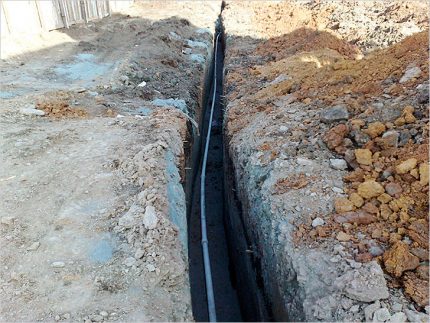
Together with digging ditches at great depths, you will have to equip a head - to install a caisson, where pumping equipment is usually located. These are costly and irrational measures, for the implementation of which it is necessary to attract special equipment.
To save money, to make maintenance of the water supply system easier, it is laid at a shallow depth, using various means of insulation - from thermal insulation material to the heating cable.
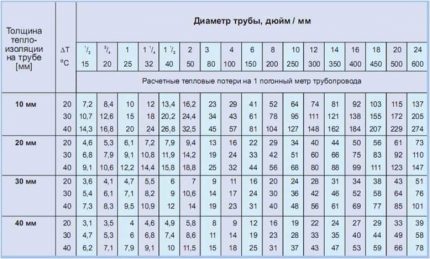
Often, the method of heating the underground water supply is chosen based on installation conditions and considerations of economy. Sometimes it is more beneficial to combine two different technologies.For example, a cable is mounted along the entire length of the pipe, including the end lowered into the well, and the part located in the ground is insulated from above with a polystyrene foam sheath.
Method # 1 - using insulation
The traditional and most popular method of heating pipes buried in the ground, as well as “air” water pipes, is mechanical insulation, which is produced using special materials.
The shell is selected based on the conditions of a particular region and the particular characteristics of the geological situation, for example, soil aggressiveness or the presence of high groundwater.
There are a number of requirements for materials. They should possess such qualities as:
- low thermal conductivity - the key to energy efficiency and savings;
- wear resistance, long term of operation without loss of basic qualities;
- resistance to organic and chemical substancesas well as soil microorganisms and bacteria;
- lack of deformation at high humidity and low temperatures.
Typically, manufacturers accompany the product with a list of technical characteristics that must be considered when choosing alternative options. There are times when the shell of extruded polystyrene foam use much more rationally than expensive polyurethane sprayers.
Popular heaters:
All of these materials are relevant, they can be easily found on sale. Preference should be given to insulation with low thermal conductivity, high strength.
It is easier to install one that does not require an additional tool, has a light weight and small volume, and lends itself well to processing.
Method # 2 - air insulation
This method is used in the public utilities and industry, the arrangement in the country of a protective air bag is associated with difficulties. The technology consists in supplying warm air to the channel in which the water supply is located. From above the pipe is closed by any type of thermal insulation.
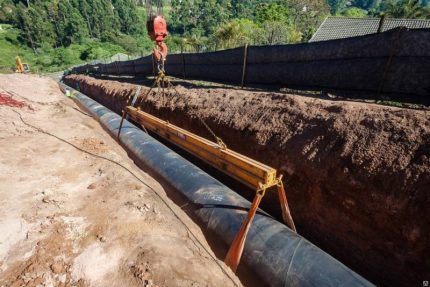
This technology has options. For example, if the diameter of the pipe is small, then it is placed in a similar product, but with a larger diameter. Such an arrangement does not allow the main with water to directly contact the soil, and therefore to cool. In addition, a small space is created between the walls through which heated air circulates.
The disadvantage of the method is the impossibility of applying for a water supply system launched on top of the earth. It is relevant only for communications located in the ground, preferably below the freezing level.
Method # 3 - high blood pressure
There are standards that establish the value network pressure with various types of water supply devices. For example, for high-rise buildings, the optimal parameters are 4-4.5 bar, while in private houses they can be more or less.
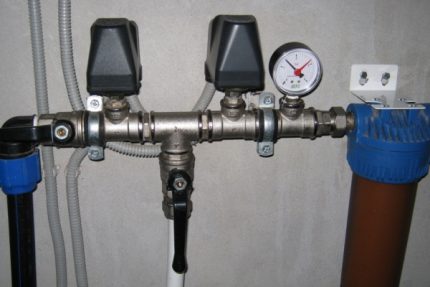
The maximum working pressure for the water supply systems of private houses is considered to be 6.5-7 bar, but such indicators are rare, more often they do not reach 3 bar. To protect the water supply from freezing, the pressure in the system is increased, say, from 3 to 5 bar.
The main condition is the installation of special equipment, since not everyone is able to withstand such a pressure.
More often the increase in pressure is used by public utilities, the owners of country houses use it extremely rarely. If the strength of the system allows, the pump is turned off for the winter season, and the pressure is raised to 5 bar.
Method # 4 - heating using electricity
Installation of heating cable is considered the most effective way of all active. The heating principle is simple: an electric current passes through a wire installed inside or outside the pipe and increases its temperature by converting electricity to heat.
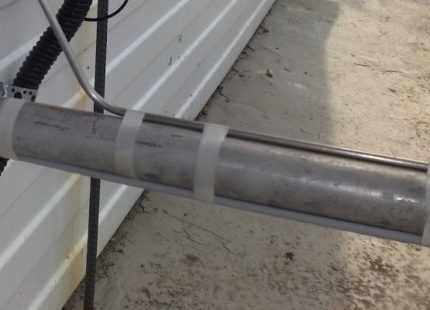
TO heating cable special requirements are made. It must be protected as much as possible from the effects of external mechanical irritants, moisture. The shell must be strong, without holes or defects.
Consider two types of cable that are actively used to heat pipes that supply water to private homes.
Option 1 - Resistive Cable
The advantage of the product is a specially selected alloy of metals with high resistance, which causes a large amount of generated heat. Of the two types of cable - single-core and two-core - the second option is more practical.
1-core requires a loopback circuit. This means that during installation, both ends must be brought to the power source. With 2-core it is simpler: the first end is connected to a power source, and the second is “closed” by putting on a contact sleeve.
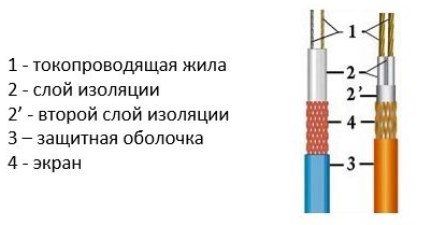
The conductors are protected by a polymer sheath, often multilayer. In addition, a grounding screen covers them from above, and from the outside - a durable heat-resistant PVC insulation.
Why choose a resistive cable? It has great heat dissipation, in other words, it heats up very much and transfers heat to the water pipe. It can be fixed along the entire length of the line, wrapped around the connecting nodes and flanges.
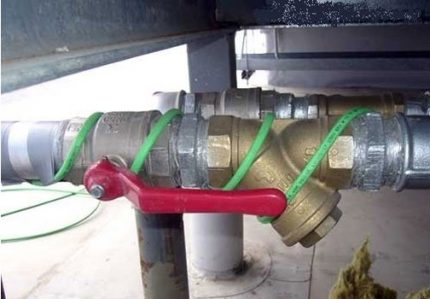
Additional advantages of the resistive option are affordable cost and ease of installation. All preparation and installation operations can be performed independently.
The disadvantages include the purchase of additional equipment: automatic machines, sensors, control units. It is believed that the end sleeve should be factory - to guarantee the safety and proper operation of the heater.
Option 2 - self-regulating heating wire
The principle of operation and cable design are fundamentally different from the first option. Self-regulating systems recognized as more economical and easy to install.
Cable structure:
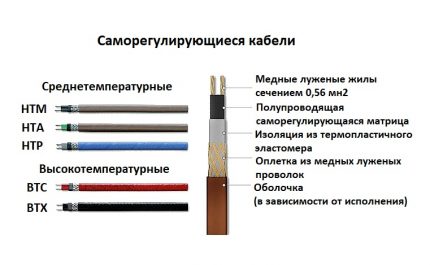
In terms of energy consumption, this type of cable looks ideal. As soon as the temperature of the air or pipe decreases, it increases energy consumption and generates more heat, and with increasing temperature, the conductivity drops sharply.
Efficiency is also increased by heating individual sections of the water supply. If the samreg is laid along the street and inside unheated rooms, then the "street", cooler sections, it will heat more. The more vulnerable the heated zone, the more heat the cable generates.
Advantages of self-regulating systems:
- energy saving;
- heating efficiency;
- distribution by "zones";
- comfortable length.
Unlike a resistive cable, which is sold ready-made and has a certain length, samreg can be cut as conveniently. Typically, the cut points are indicated on the shell, the interval between which is 20 or 50 cm.
There is a drawback too - heating of extended sections flies a pretty penny. If a low-power cable can be bought at a price of 60-75 rubles / m, then the cost of a high-quality and powerful cable reaches 300 rubles / m and higher.
Recommendations and installation instructions
It is not as difficult to close the water supply with thermal insulation as to connect heating cables, therefore, we will consider the technical nuances of installation, relating specifically to electrical equipment.
Outdoor installation of heating cable
Fastening along the outer surface of the pipe is often practiced when it is necessary to heat open sections of the water supply located in the basement, basement, and caisson.
There are two ways to fix a wire on a pipe:
- stretch along the surface along the entire length;
- wrap in a spiral.
The first option is more economical and practical if the cable power is enough to heat the pipe. In particularly cold areas, you can use the second method, but the wire consumption will increase.
Mounting occurs in the following order:
This is the easiest way to mount the heating cable.
Recommendations for the device:
- To heat a polypropylene water pipe with a diameter of up to 32 mm, it is enough to fix the cable along one side - which one does not matter. However, if it is necessary to insulate the sewer, the wire is fixed exclusively from below.
- If there is a choice of insulation, then you need to take a thicker one. Overheating of the self-regulating cable does not threaten, but heat loss will significantly decrease. The thicker the coat, the less Samreg will spend electricity, the greater the savings.
- Aluminum self-adhesive is the best material for fastening to the pipe. Acrylic adhesive does not collapse under the influence of heat, which is evenly distributed over the entire heated surface.
- The sun's rays destroy some types of insulation and fasteners, so for open areas it is better to choose black clamps and adhesive tape that does not respond to UV radiation.
If the cable is mounted not in a straight line, but with a spiral, then the insulation will occur according to the same principle - putting on a "coat" and fixing with clamps. Without a heater, part of the energy will be wasted on heating the air.
The nuances of connecting a self-regulating cable
It is not practical to pull the wires to the pipe from the shield, so the samreg is connected to the power cable, which, in turn, is simply plugged into the outlet if necessary. To work, you will need a building hair dryer, a knife, a set of heat-shrink tubes for crimping and sleeves for connecting contacts.
It should be remembered that electrical equipment in a humid environment becomes more dangerous, therefore, special attention must be paid to tightness.
Connection photo instruction:
As you can see, the difficulties in cable installation No, just all the manipulations must be performed very carefully and consistently.
When choosing a power cable, the location of the outlet must be considered. If it is next to the pipe, you can buy the shortest product, but more often you have to purchase a 4-5-meter cord.
It remains to squeeze the end of the samreg:
With a hermetically sealed end, the cable is fully operational. So that the water pipe does not freeze, it remains to fix the samreg along the entire length of the highway, insulate it and insert the plug into the outlet.
In some cases, the installation of an external cable is considered unsuccessful, for example, if it passes through floor slabs or concrete blocks of a well. Then apply the internal installation.
If it is better to use a flat type product for external heating, then a special cable with a round cross-section and especially reliable waterproofing is suitable for internal heating.
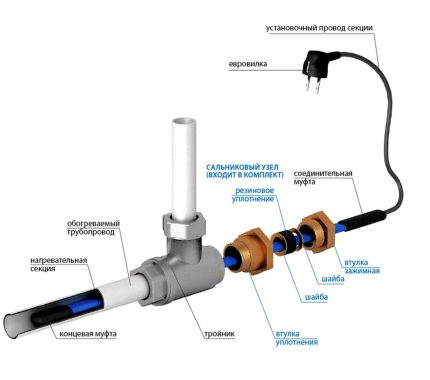
Indoor installation heating cable requires special care and compliance with certain rules. For example, you cannot run the cord through the nodes where threaded connections protrude from the inside - sharp edges can damage the protective sheath.
Conclusions and useful video on the topic
Video # 1. Outdoor installation instruction:
Video # 2. Detailed description of the indoor installation:
Video # 1. Practical use in summer conditions:
If you choose the right method of warming the water supply system and perform installation work in compliance with the rules, then there will be no problems with pipes in the winter. The insulation of the mains laid in the ground should be taken care of in advance, and open areas can be insulated at any convenient time..
Want to talk about how the water main was insulated in your own suburban area? There is information on the choice of material and technology of its installation, which is worth sharing with visitors to the site? Please write comments in the block below, ask questions, post a photo on the topic of the article.

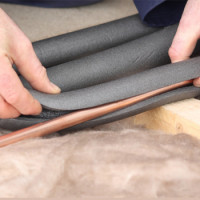 Insulation for water pipes: the choice and methods of laying thermal insulation of water pipes
Insulation for water pipes: the choice and methods of laying thermal insulation of water pipes 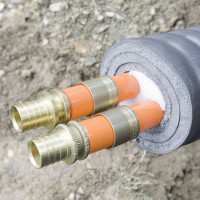 Water supply insulation in the ground: rules for thermal insulation of external branches
Water supply insulation in the ground: rules for thermal insulation of external branches 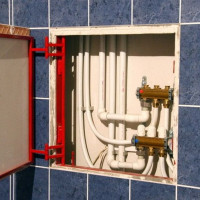 Water distribution in a private house: design rules + an overview of the best schemes
Water distribution in a private house: design rules + an overview of the best schemes 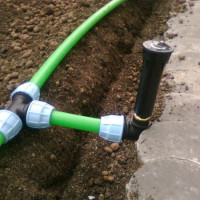 How to organize a summer water supply in a country house: laying and arranging a water supply for irrigation
How to organize a summer water supply in a country house: laying and arranging a water supply for irrigation 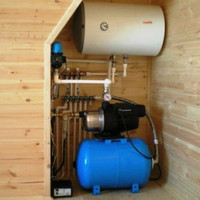 DIY private house water supply
DIY private house water supply 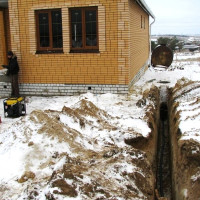 How to organize the introduction of water into the house: the choice of water supply method + arrangement options
How to organize the introduction of water into the house: the choice of water supply method + arrangement options  How much does it cost to connect gas to a private house: the price of organizing gas supply
How much does it cost to connect gas to a private house: the price of organizing gas supply  The best washing machines with dryer: model rating and customer tips
The best washing machines with dryer: model rating and customer tips  What is the color temperature of light and the nuances of choosing the temperature of the lamps to suit your needs
What is the color temperature of light and the nuances of choosing the temperature of the lamps to suit your needs  Replacement of a geyser in an apartment: replacement paperwork + basic norms and requirements
Replacement of a geyser in an apartment: replacement paperwork + basic norms and requirements
With regard to the self-regulating cable, an explanation must be made: it is regulated not by the outside air temperature, but by the temperature of the cable itself. For most brands, it is 35-45 degrees (there are still high-temperature ones - 75-80). So it’s not worth counting on the fact that in warm weather it will not consume electricity. At a minimum, the water in the pipe is always below the indicated temperatures.
Two years ago, I installed home water supply.And due to the low professionalism of the workers, she was left without water in the coldest weather, since they did not insulate the pipe, assuring me that it was deep underground and it was not afraid of frost. In the spring, I called other specialists who made pipe insulation using a “shell” of water-repellent material, so last winter there was no problem with the water supply. The material used for insulation, although expensive, but fully fulfills its purpose.
My water pipe enters the cold basement of the house, and sometimes it picks up water in severe frosts, although the entire pipe is insulated with the help of a heater insulation for pipes “Energoflex”. I heard about heating cables that they can be used for heating. I want to apply your installation technology, I prefer a self-regulating cable to save energy and nerves.